Acrosathe annulata

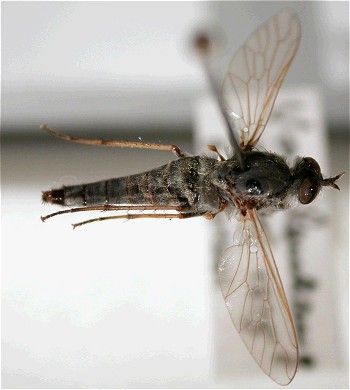
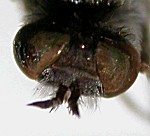
Compiled by Mark van Veen
Couwenhoven 42-27
NL - 3703 ED Zeist
based on
Haarto A. and Winqvist K. 2006. Finnish flies of the family Therevidae. Entomologica Fennica 3: 46-55
Kröber O. 1925. 26. Therevidae, in: Lindner E. Die Fliegen der Palaearkischen Region.
Lyneborg L. 1965. Tovinger IV, humfluer, stilefluer rovfluer M.Fl. Danmarks Fauna 70. G.E.C. Gads Forlag.
Seguy E. 1926. Dipteres Brachyceres. Faune de France 13.
Stubbs A. and Drake M. 2001. British Soldierflies and their allies. British entomologiscal and natural history society.
Van der Goot V.S. 1985. De Snavelvliegen (Rhagionidae), Roofvliegen (Asilidae) en aanverwante families van noordwest-Europa. KNNV wetenschappelijke mededeling 171. KNNV Uitgeverij, Utrecht.
Internet sources
The definite Therevidae source is the PEET Therevidae site:
http://www.inhs.uiuc.edu/cee/therevid/
If have taken some pictures of types from this site, these are
recognized by a MEI number.
1.b. Antenna: first antennal segment much longer than the head -> 9
2.a. Antenna: first segment elongate, as wide as third segment -> 3
2.b. Antenna: first segment swollen, wider than third segment. Male: frons haired, face bare. 7.5-12 mm. -> Dialineura ( 1 species: Dialineura anilis Linnaeus)
3.a. Face haired -> 4
3.b. Face bare. -> 6
4.a. Male with abdominal hairs predominantly silver. Female frons entirely dull -> 5
4.b. Male with abdominal hairs brown to black (not predominantly silver). Female frons with one or two shining black patches -> Thereva
5.a. Halteres with pale club; wing: 4th hind border cell closed. Male: tergite 8 with shallow notch. Female: thorax with erect pale hairs, rarely dark -> Acrosathe
5.b. Halteres with dark club; wing: 4th hind border cell open. Male: tergite 8 with deep apical notch. Female: thorax with dark hairs -> Spiriverpa
6.a. Tibia partly bright reddish; halteres yellow. Male: frons small (equal to front ocellus between eyes) or wide -> 7
6.b. Tibia blackish to dark red; halteres black. Male: frons wide, eyes separated by a width wider than the front ocellus. -> Dichoglena
7.a. Femora entirely black, they may be civered with silver dust -> 8
7.b. Femora black with yellow apex. Male: genitalia reddish. Female: tergites 5-6 with triangular silver markings -> Cliorisma
8.a. Males: eyes separated by a distance wider than the front ocellus. Females: frons entirely dusted; tergite 5-6 with barshaped silver markings. -> Pandivirilia
8.b. Males: eyes almost meeting, separated by a distance less than the front ocellus. Females: frons partly shining black -> Psilocephala
9.a. Antenna: third segment without arista, only with a bristle near the top -> Euphycus
9.b. Antenna: third segment with an arista of two segments, the first small and not always good visible, the second long -> Salentia
1.b. Male: femur 2 without anteroventral bristles; eyes are barely separated. Female: tergites 5-8 with all erect hairs white; end of abdomen with the bristles in the slender fans pale. 8-11 mm. -> Acrosathe baltica Andersson



Preferred environment: Dry open sands,
common in coastal dunes, dispersed in inland dunes. Adult
habitat and habits: On open spots of sand. The males are
recored to form swarms at 2-3 meters above the ground (Stubbs and
Drake, 2001). Flight period: Early may to early
september. Range: Western Europe, Northern Africa,
Turkey. Identification: Van der Goot (1985), Stubbs
and Drake (2001).
Acrosathe baltica
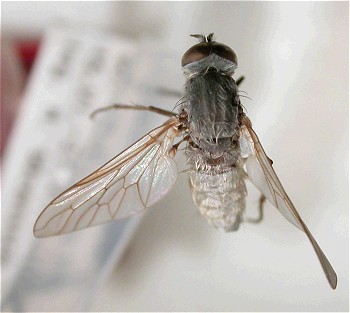
Preferred environment: unknown. Adult
habitat and habits: unknown. Flight period:
unknown. Range: Baltic states. Identification:
Stubbs and Drake (2001).
Cliorisma
1.b. Male: genitalia: aedeagus short and with a single, downwards bend. Female: tergite 2 and 3: the black markings do not reach the front corners. 9-11 mm. -> Cliorisma ardea Fabricius

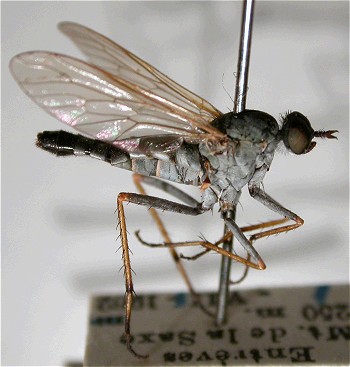
Preferred environment: (Wet?) forests. Adult
habitat and habits: unknown. Flight period:
Mid June to early September. Range: Central and
Westen Europe, east to the Caucasus. Identification:
Van der Goot (1985).
Dialineura
Dialineura anilis

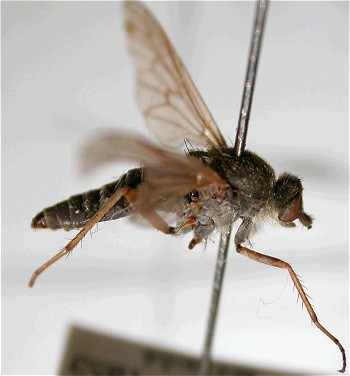
Preferred environment: Dry sandy soils in
open to shadowed conditions, in coastal dunes in Ammophiletum.
Also found in dry oak forests near sandy paths. Adult habitat
and habits: Adults walk on the sand. Females also sit in the
vegetation near the ground. Flight period: Mid May
to end July. Range: Western Europe. Identification:
Van der Goot4 (1985), Stubbs and Drake (2001). The thickened first
antennal segment is distinctive.
Dichoglena
Dichoglena used to be in the genus Psilocephala.

2.a. Male: abdomen in top view black with silverish dust only at the side margin. Female: tergite 6 shiny black. 10-13.5 mm. -> Pandivirilia caesia Meigen
2.b. Male: abdomen in top view (almost) completely silverish dusted. Female: tergite 6 greyish dusted. 10-13.5 mm. -> Pandivirilia melaleuca Loew
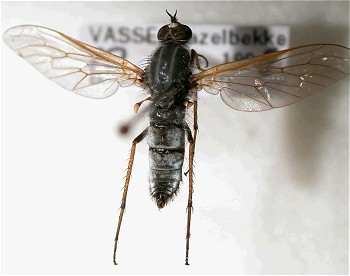
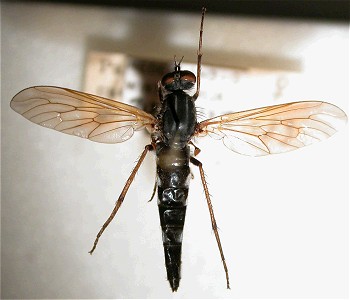
Preferred environment: little stream
marshes at the start of streams. Adult habitat and habits:
unknown. Flight period: June. Range:
?. Identification: Van der Goot (1985).
Pandivirilia eximia
Range: Finland. Identification:
inadequately differentiated in existing keys. The old keys by Krober
and Seguy do not treat P. caesia.
Pandivirilia melaleuca
Preferred environment: oak forests, adults
have been found assembling at a stream (Allen , 1982). Adult
habitat and habits: females are observed zig-zagging close to
the ground, adults were observed assembling at a stream, flying up and
down now and then. Flight period: May to end of
July. Range: Central belt of Palaearctic region,
from Great Brittain to Pacific coast. Identification:
Van der Goot (1985), Stubbs and Drake (2001).
Psilocephala
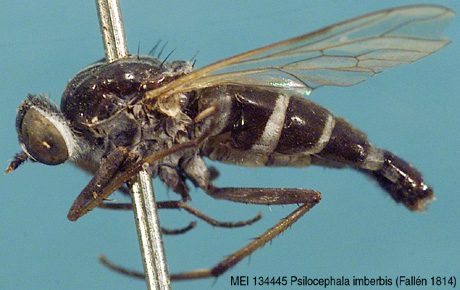

Female. lectotype, head, from the PEET Therevidae Mandala database.
Range: Finland, Sweden.
Spiriverpa
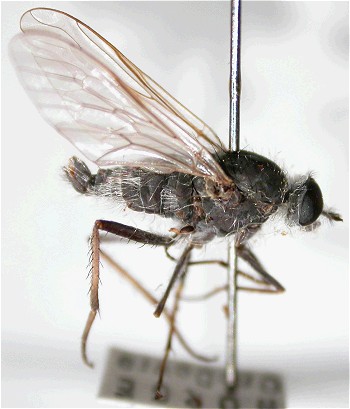
Preferred environment: Dry sandy sediment
besides rivers and streams. Adult habitat and habits:
walks on the sandy sediments, especially where sparse vegetation has
developed. Flight period: Late May to mid August. Range:
Great Brittain, Fennoscandinavia. Identification:
Van der Goot (1985), Stubbs and Drake (2001).
Thereva
Not included yet is Thereva fuscinervis
Zetterstedt. Needs to be done, but I have no access to material.
0.b. Femora yellow -> Thereva aurata, a conspicuous southern species]
1.a. Male: the eyes meet on the frons -> 2
1.b. Females: the eyes are widely separated -> 16
Males
2.a. Femur 3: below at the base with two rows of bristles, a posteroventral of 1-4 bristles in addition to the anteroventral row -> 3
2.b. Femur 3: below at the base only with a single row of anteroventral bristles -> 8
3.a. Tergite 4-5 predominantly grey (compared to black parts): the blackish band at the front margin of tergite 4-5 narrow and triangular, leaving the side margin grey -> 4
3.b. Tergites 4-5 predominantly black: the blackish band at the front margin af the tergite 4-5 wider and not narrowed much towards the side margin, leaving the side margin of tergite 4-5 half black, half grey -> 6
4.a. Thoracic dorsum: two pairs of dorsocentral bristles; femur 3: the bristles below at the tip nicely arranged in a single row. 9-11 mm. -> Thereva inornata Verrall
4.b. Thoracic dorsum: onw pair of dorsocentral birstles; femur 3: the bristles below at the tip not nicely arranged in a single row, but displaced from the central line -> 5
5.a.Thoracic dorsum with two clear yellowish longitudinal stripes and a dark central stripe; wing with a whitish tint, veins dark brown, cross veins darkened; face: hairs below the eye whitish. 6.5-8 mm. -> Thereva marginula Meigen
5.b. Thoracic dorsum with hardly visible greyish stripes, without dark central stripe; wing usually greyish, veins pale brown, cross veins not or somewhat darkened; face: hairs below the eyes mixed black and white. 6-8.5 mm. -> Thereva bipunctata Meigen
6.a. Head: the hairs on the lower part of the head behind the eyes mixed black and white; tergites 2-3 almost entirely black; thoracic dorsum usually with two pairs of dorsocentral bristles; wing darkened with a darkened patch from cross vein r-m to the discal cell. 8.5-10.5 mm. -> Thereva cincta Meigen
6.b. Head: the hairs on the lower part of the head, behind the eyes all white; tergite 2-3: hind margin with whitish stripe that widens towards the side margin; thoracic dorsum: usually one pair of dorsocentral bristles; wing greyish, cross veins somewhat darkened -> 7
7.a. Thoracic dorsum characteristically blueish grey, wihtout dark central line (at most a trace); tergite 1: at least the cetnral part with pale hairs; phallus of the aedeagus strongly bend like an S. 9-10.5 mm. -> Thereva strigata Fabricius
7.b. Thoracic dorsum greyish brown, usually with a clear dark central line; tergite 1: hairs all black or dark brown; phallus of aedeagus weakly bend, only nodding at the tip. 6-10.5 mm. -> Thereva plebeja Linnaeus
8.a. Tergites: all are entirely greyish or yellowish dusted, without undusted, black to brown front parts -> 9
8.b. Tergites: at least tergite 2-5 undusted black to brown in front part -> 11
9.a.Femur 1-2 without bristles below at the tip; frons and face with numerous yellowish hairs, black hairs only at the eye margins. 9.5 mm. -> Thereva oculata Egger
9.b. Femur 1-2 with a few bristles below at the tip -> 10
10.a. Club of halteres yellowish brown. 8 mm. -> Thereva fulva Meigen
10.b. Club of halteres brownish black. 7.5-10.5 mm. -> Thereva cinifera Meigen
11.a. Femur 3: anteroventral bristles on basal half not exactly in a single row, some are displaced from the central line or some bristles beyond the row are present at the basis of the femur. 8-12 mm. -> Thereva nobilitata Fabricius
11.b. Femur 3: the anteroventral bristles exactly in a single row, never bristles beyond the row at the basis of the femur -> 12
12.a. Scutellum: hairs whitish, at most with a few black; phallus of aedeagus in lateral view short, nodding just at the tip -> 13
12.b. Scutellum: hairs yellowish or blackish; phallus of aedeagus in latareal view long, bend at 1/4th to 1/3rd from the tip -> 14
13.a. Tibia 1 longer than femur 1; body in dorsal view: head as broad as thorax; femur 1 with some anteroventral bristles. 9-11 mm. -> Thereva microcephala Loew
13.b. Tibia 1 of equal length as femur 1; body in dorsal view: head broader than thorax; femur 1 without anteroventral bristles. 9-11 mm. -> Thereva lanata Loew
14.a. Tergite 2-4: dark bands at front margin narrow and badly demarcated. 9.5 mm. -> Thereva oculata Egger
14.b. Tergite 2-4: dark bands at front margin broad and well demarcated -> 15
15.a. Scutellum with dense yellowish hairs; tergites with contrasting blackish and yellowish bands, hairs on median part of dark bands blackish, yellowish on other parts; thoracic dorsum yellowish grey with two faint yellow longitudinal stripes, without dark central stripe; dorsocentral bristles: two pairs. 9.5-12.5 mm. -> Thereva handlirschi Loew
15.b. Scutellum with sparse, blackish hairs; tergites almost completely blackish, only the hind corners with greyish dust, their hairs predominantly blackish with yellowish hairs only at the lateral margin; thoracic dorsum greyish brown with two faint greyish longitudinal stripes and a dark central stripe; dorsocentral bristles: usually one pair. 9-13 mm. -> Thereva valida Loew
Females
16.a. Frons: a single black spot, at most with a vaguely marked dust line on the middle -> 17
16.b. Frons: two, well separated spots -> 28
17.a. Frons with a broad spot that is about as high as long -> 18
17.b. Frons with a black stripe, that is much narrower than long; femur 3: anteroventral bristles exactly in one row. 9.5-12.5 mm. -> Thereva valida Loew
18.a. Tergites 2-3 uniformly yellowish or greyish dusted, without dark bands at front margin -> 19
18.b. Tergites 2-3 with a dark band at the front margin and yellowish to greyish dusted in hind part -> 20
19.a. Halters yellowish; tergite 7
shining black, only dusted near lateral margin; frons: the black spot
reaches the front ocellus. 9.5-10.5 mm. -> Thereva
fulva Meigen
19.b. Halteres blackish; tergite 7 greyish dusted; frons: the black spot does not reach the front ocellus. 7.5-11 mm. -> Thereva cinifera Meigen
20.a. Femur 1-2 without anteroventral row of bristles; frons: black spot reaches all ocelli and extends to rim of head; tergites shining black at front part and whitish dusted at hind part. 9-13.5 mm. -> Thereva lanata Zetterstedt
20.b. Femur 1-2 with anteroventral row of bristles; frons: black spot reaches at most the front ocellus -> 21
21.a. Tergite 2-4: the black frontal band reaches the hind margin in the middle, separating the grey dust band in two. 10.5-13 mm. -> Thereva microcephala Loew
21.b. Tergite 2-4: the black frontal band does not reach the hind margin, an entire greyish dust band along the hind margin present -> 22
22.a. Tergite 4-6: lateral margin entirely shining black; thoracic dorsum with two yellowish grey longitudinal stripes and two pairs of dorsocentral bristles. 9-11 mm. -> Thereva cincta Meigen
22.b. Tergite 4-6: lateral margin partly greyish dusted, only shining black on frontal part -> 23
23.a. Halteres yellowish to brownish; tergite 3: frontal band brownish, medianly half the width of the tergite (sometimes frontal band badly marked and somewhat dusted, then confusion with T. fulva may arise. However, the black spot on the frons does not reach the front ocellus for T. nobilitata, while it does in T. fulva); femur 3: on the ventral side on the basis with bristles in two rows. 9-13 mm. -> Thereva nobilitata Fabricius
23.b. Halteres blackish; tergite 3: frontal band blackish, medianly wider than half the width of the tergite -> 24
24.a. Frons: the black spot reaches the compound eyes over a considerable distance -> 25
24.b. Frns: the black spot is separated from the compound eyes by a dusted stripe along the eye margin -> 26
25.a. Thoracic dorsum greyish brown with two pale longitudinal stripes and usually with a dark central stripe; bristles in terminal circlet on tip of abdomen short, broad and blunt. 8-12.5 mm. -> Thereva plebeja Linnaeus
25.b. Thoracic dorsum blueish grey with badly marked pale longitudinal stripes and without dark central stripe (at most a trace at the hind part of the dorsum); bristles in the terminal circlet on the tip of the abdomen long thin and acute. 9-13 mm. -> Thereva strigata Fabricius
26.a. Tergite 3: lateral margin (almost) entirely greyish dusted: the black frontal band does not reach it; wing with a whitish tint and darkbrown veins surrounded by darkish infuscation. 9-9.5 mm. -> Thereva marginula Meigen
26.b. Tergite 3: lateral margin shining black on frontal part -> 27
27.a. Femur 3: anteroventral row of bristles forms a single line, posteroventral bristles absent; scutellum with golden yellow hairs; thoracic dorsum with two pairs of dorsovcentral bristles. 10-14 mm. -> Thereva handlirschi Krober
27.b. Femur 3: anteroventral row of bristles with some bristles displaced from the central line, usually with some posteroventral bristles; scutellum with mixed yellow and black hairs. 9.5-12.5 mm. -> Thereva inornata Verrall
28.a. Tergite 2-4 without blackish frontal bands; femur 1-2 without anteroventral bristles. 10-12 mm. -> Thereva oculata Egger
28.b. Tergite 2-4 with blackish frontal bands; femur 1-2 with anteroventral bristles. 8-10 mm. -> Thereva bipunctata Meigen
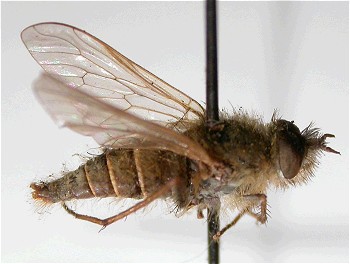

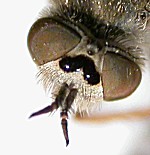
Preferred environment: Sparsely vegetated
sands in coastal dunes, in The Netherlands sometimes abundant on higher
and sandy parts of saltmarshes. Adult habitat and habits:
adults walk on the ground in sparsely vegetated sands. Flight
period: mid June to early September. Range:
Central part of Europe, from Great Britain east to Japan. Identification:
Van der Goot (1985), Stubbs and Drake (2001).
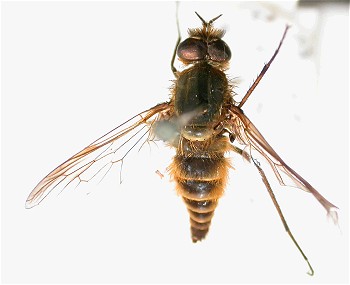
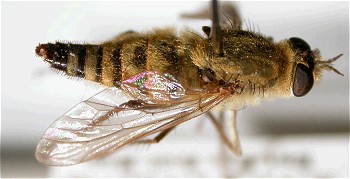
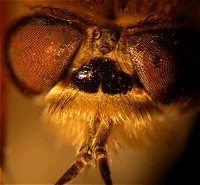
Preferred environment: at the forest edge
on dry, sandy grounds (Van der Goot, 1985; Stubbs and Falk, 2001). Adult
habitat and habits: on the ground and in the vegetation. Flight
period: mid August to early October. Range:
Central and Northen Europe. Identification: like T.
nobilitata, but flight period later.
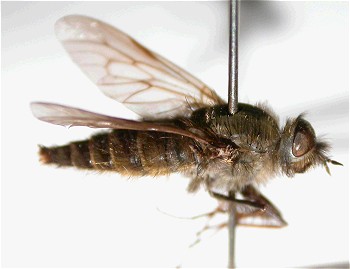
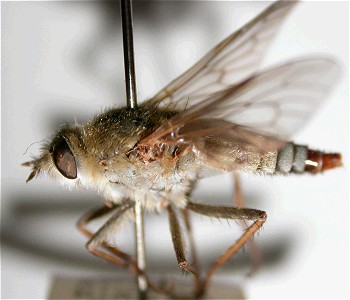
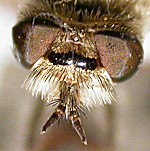
Preferred environment: river banks and
inland sands (Stubbs and Falk, 2001). Adult habitat and habits:
unknown. Flight period: mid June to early
September, peak in July. Range: Central nad
Northern Europe. Identification: rather small
species with light greyish to yellow colour.
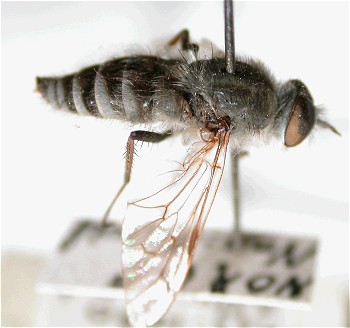
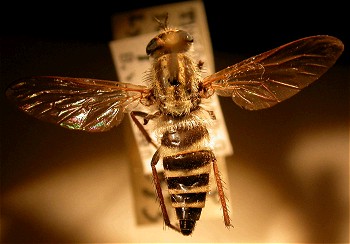
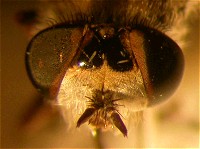
Female, from the Netherlands (ZMAN)
Preferred environment: dry, sandy
environment, heaths. Adult habitat and habits:
presumably on the ground. Flight period: early Jne
to mid July. Range: Central and Northern Europe,
Russia. Identification: greyish species. Females
have a unique large frontal spot that reaches the hind ocelli.
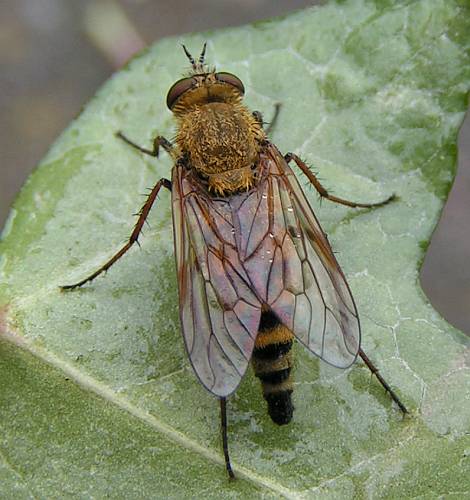
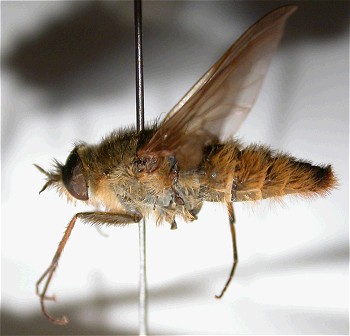
male, ZMAN, det Lyneborg.
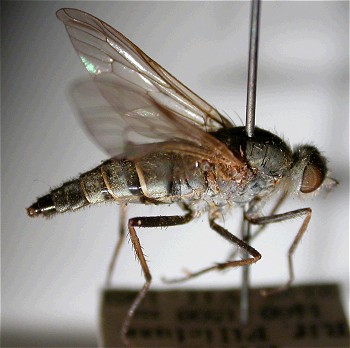
female, ZMAN, det Lyneborg
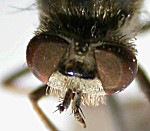
female head.
Preferred environment: forest edges and
hedges on dry, sandy soils. Adult habitat and habits:
adults sit on the foliage or on the ground (often the males only). Flight
period: late May to mid September. Range:
Central and Northern Europe. Identification: Van
der Goot (1985), Stubbs and Drake (2001). Most common Thereva
that hides other species in the field. T. nobilitata
is a brownish summer species, so check for greyish species and species
beyond summer.
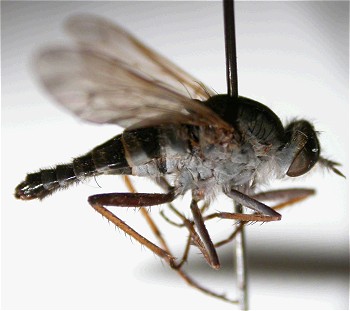
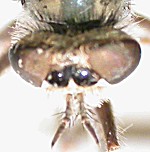
Preferred environment: disturbed and
usually sandy soil (Stubbs and Drake, 2001), chalk hills (Van de Goot,
1985). Adult habitat and habits: adults on the
foliage and on the ground. Flight period: late
April to late August. Range: Central nad Northern
Europe, presumably east to Pacific coast. Identification:
Van der Goot (1985), Stubbs and Drake (2001). Robust species, banded
with grey and black (Stubbs and Drake, 2001).
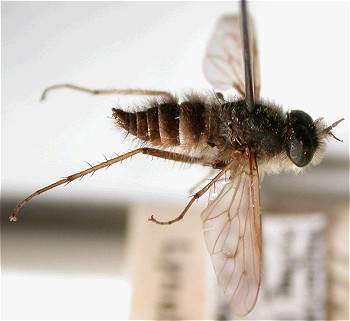
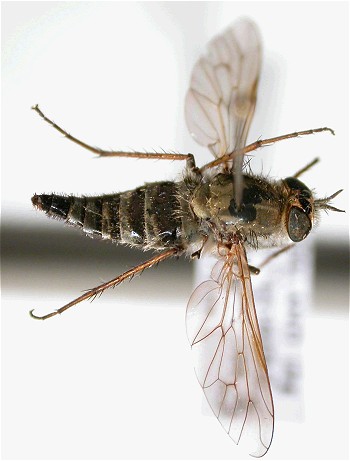
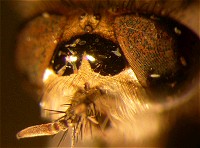
Preferred environment: unknown. Adult
habitat and habits: unknown. Flight period:
unknown. Range: Europe. Identification:
Van der Goot (1985).
Thereva unica

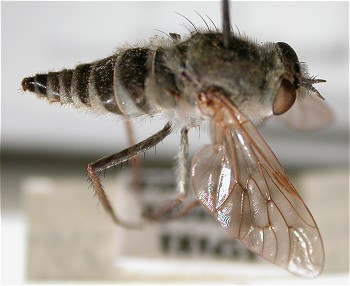
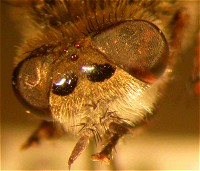
Preferred environment: Most abundant in
coastal dunes, from the seaside Ammophiletum parts to the more fixed
dunes. Inland on parts with open sands. Adult habitat and
habits: Adults walk on the bare sand or sit low in the
vegetation. Flight period: late May to early
September. Range: central part of Europe, west to
Great Britain, east into Siberia. Identification:
Known as Thereva bipunctata in recent literature.
Males greyish, with tergite tricolored: black in front, a white band at
the hind margin and greyish durst in between.
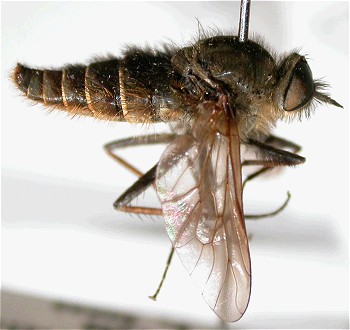
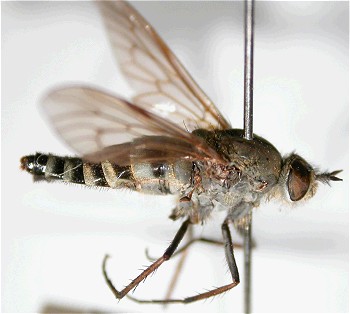
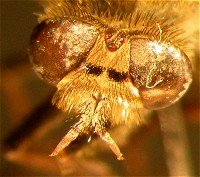
Preferred environment: . Adult habitat and habits: . Flight period: . Range: Northern and central Europe, Great Britain. Identification: Van der Goot (1985), Stubbs and Drake (2001).
Last updated 20-08-2015